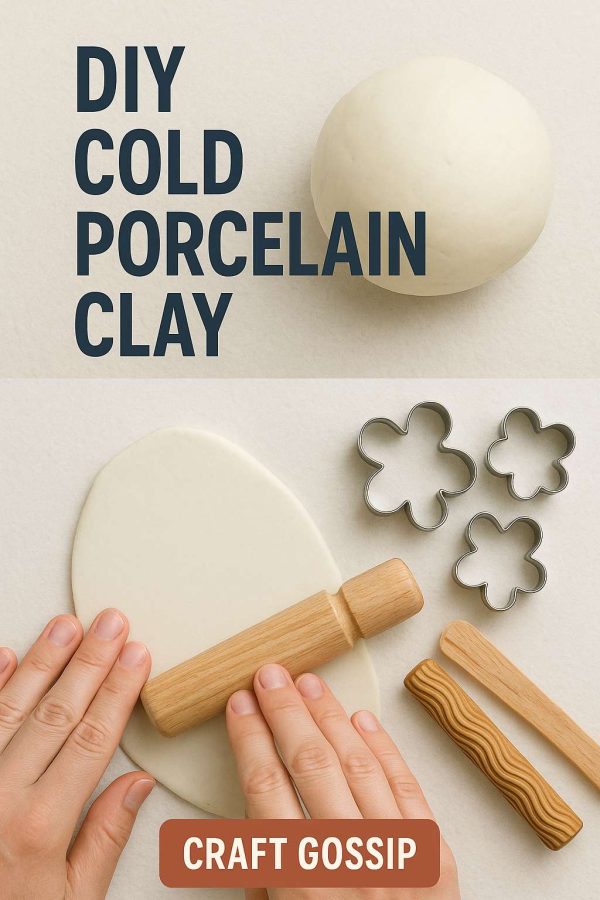 I’m in the process of making some bottles into tumblers by cutting off the tops and grinding them top of the glass to even it out. I’m using a tile saw and it’s a bit uneven sometimes. When I saw this project over at Instructables and I’ve decided to put it higher on my list of things to do. Looks like it’ll save me some grinding. I don’t mind that. And I’ll get that many more bottle repurposed. Very cool all the way around!
I’m in the process of making some bottles into tumblers by cutting off the tops and grinding them top of the glass to even it out. I’m using a tile saw and it’s a bit uneven sometimes. When I saw this project over at Instructables and I’ve decided to put it higher on my list of things to do. Looks like it’ll save me some grinding. I don’t mind that. And I’ll get that many more bottle repurposed. Very cool all the way around!
Have you read?
Cold Porcelain Clay: What It Is, How to Make It and Crafting Tips
Cold porcelain clay has been around for decades, but it’s having a bit of a comeback in today’s DIY circles. Unlike polymer clay or ceramic clay, this clever medium doesn’t need baking or firing. It’s air-dry, inexpensive, and you can make it right in your kitchen with simple ingredients.
If you’ve ever wanted to try clay crafting but felt intimidated by ovens, kilns, or pricey supplies, cold porcelain is a wonderful place to start.
What is Cold Porcelain Clay?
Despite its name, cold porcelain contains no actual porcelain. Instead, it’s a soft, pliable, air-dry clay made from cornstarch and white glue. The finished pieces dry to a smooth, porcelain-like finish—hence the name.
Crafters love it because:
- It’s lightweight and flexible before drying
- Dries hard and smooth without needing baking
- Can be sanded, painted, and varnished
- Uses inexpensive, household ingredients
Cold Porcelain Clay vs. Polymer Clay
Many people confuse cold porcelain with polymer clay, but the two are quite different:
- Cold Porcelain: Air dries, slightly translucent, non-toxic, made with glue and starch. Best for delicate flowers, figurines, jewelry, and miniatures.
- Polymer Clay: Needs baking to cure, heavier, comes in many colors, more durable for items like beads and home décor.
Think of cold porcelain as the “light and airy” cousin of polymer clay—perfect when you want detail without bulk.
DIY Cold Porcelain Clay Recipe
Here’s a tried-and-true recipe you can whip up at home:
Ingredients:
- 1 cup cornstarch
- 1 cup white craft glue (like Elmer’s or PVA)
- 1 tbsp white vinegar or lemon juice (prevents mold)
- 1 tbsp baby oil or mineral oil (adds flexibility)
- Optional: acrylic paint for color
Instructions:
- Mix all ingredients in a non-stick pan.
- Cook over low heat, stirring constantly until the mixture thickens into a dough.
- Remove from heat and let cool slightly.
- Knead until smooth and pliable.
- Store in an airtight container or wrap tightly in plastic wrap.
Tip: If it feels sticky, dust your hands with a bit of cornstarch while kneading.
How to Use Cold Porcelain Clay
The fun part is what you can make with it! Some ideas include:
- Realistic flowers for cake toppers or keepsakes
- Miniature figurines and dollhouse accessories
- Jewelry pieces like pendants and earrings
- Christmas ornaments and seasonal décor
- Embellishments for mixed media art
Because it’s so fine-textured, cold porcelain is especially beloved by flower artists who want lifelike petals and leaves.
Painting & Finishing
Once dry, you can paint cold porcelain with acrylic paints, watercolor washes, or mica powders. To seal and protect, brush on a coat of clear varnish or polyurethane. This helps lock out moisture and gives your project a polished finish.
Pros and Cons of Cold Porcelain Clay
Pros:
- Inexpensive to make
- No baking or kiln required
- Dries to a porcelain-like finish
- Great for detail work
Cons:
- Not waterproof (needs sealing)
- Can crack if dried too quickly
- Less durable than polymer clay for heavy-use items
Tips for Success
- Work in small batches: It can dry quickly once exposed to air.
- Keep hands lightly oiled to prevent sticking.
- Store properly: Wrap tightly and keep in the fridge for longer shelf life.
- Seal finished projects: Always varnish if they might come into contact with moisture.
Why Try Cold Porcelain Clay?
Cold porcelain is one of those classic DIY mediums that’s easy, budget-friendly, and incredibly rewarding. Whether you’re making delicate flowers, ornaments with the grandkids, or testing your hand at jewelry making, it’s a versatile clay worth keeping in your craft cupboard.
